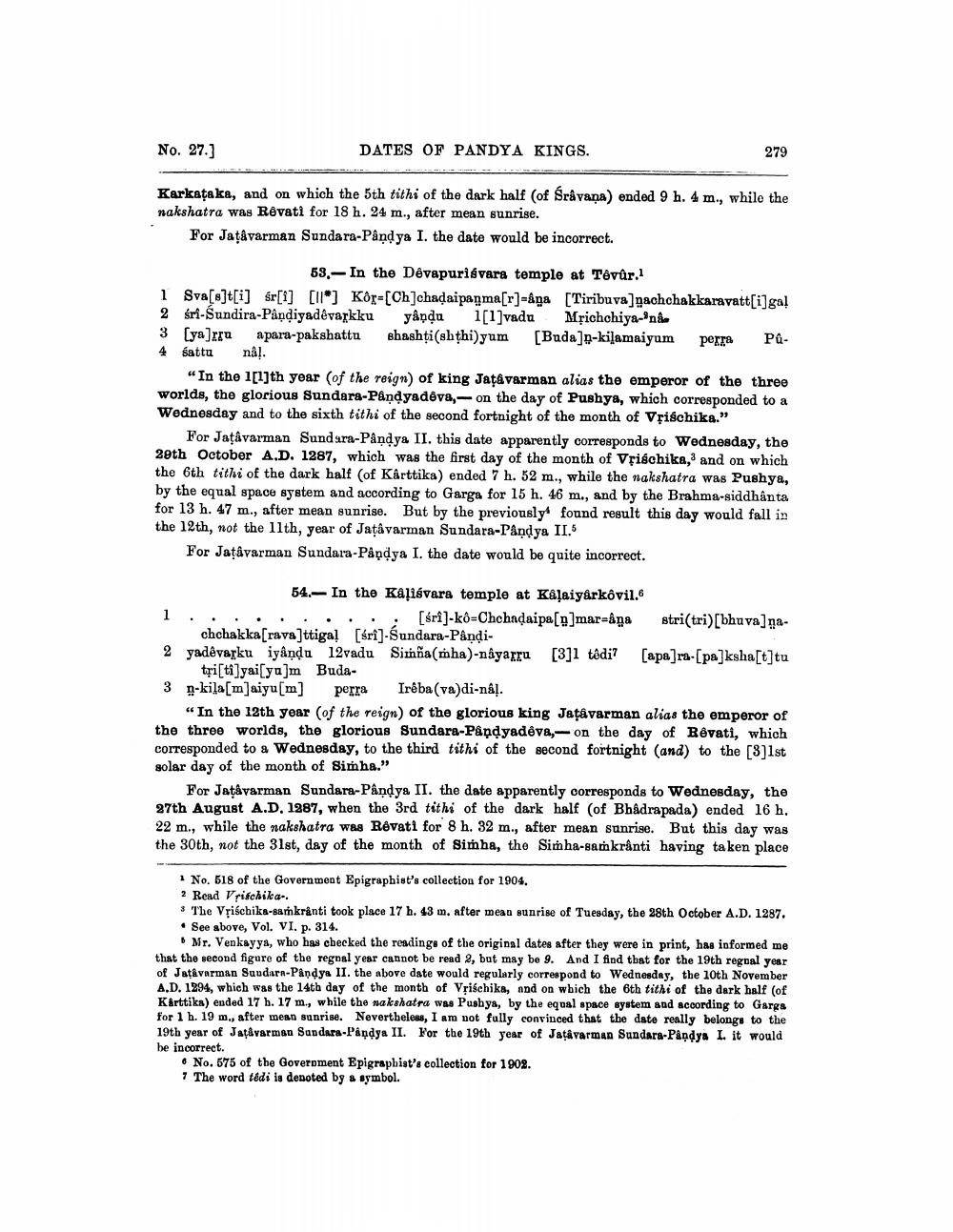________________
No. 27.]
DATES OF PANDYA KINGS.
Karkataka, and on which the 5th tithi of the dark half (of Śrâvana) ended 9 h. 4 m., while the nakshatra was Rêvati for 18 h. 24 m., after mean sunrise.
For Jațâvarman Sundara-Pandya I. the date would be incorrect.
53.- In the Dêvapurisvara temple at Têvûr.1
1 Sva[][][] [*] Kor=[Ch]chadaipagma[r]-âga [Tiribava]pachchakkaravatt[i]gal 2 śri-Sundira-Pandiyadêvarkku yâṇḍu 1[1]vadu Mrichchiya-ni shashti (shthi) yum [Buda]p-kilamaiyum
3 [ya]ru
apara-pakshattu
4 sattu nål.
279
"In the 1[1]th year (of the reign) of king Jatavarman alias the emperor of the three worlds, the glorious Sundara-Pandyadeva,- on the day of Pushya, which corresponded to a Wednesday and to the sixth tithi of the second fortnight of the month of Vrischika."
For Jatavarman Sundara-Pândya II. this date apparently corresponds to Wednesday, the 29th October A.D. 1287, which was the first day of the month of Vrischika,3 and on which the 6th tithi of the dark half (of Kârttika) ended 7 h. 52 m., while the nakshatra was Pushya, by the equal space system and according to Garga for 15 h. 46 m., and by the Brahma-siddhânta for 13 h. 47 m., after mean sunrise. But by the previously found result this day would fall in the 12th, not the 11th, year of Jațâvarman Sundara-Pandya II.5
For Jatavarman Sundara-Pânḍya I. the date would be quite incorrect.
54. In the Kâlisvara temple at Kalaiyarkovil.6 [śri]-kô-Chchadaipa[n]mar=âna
1.
perra Pû
stri(tri)[bhuva)ga
chchakkarava]ttigal [del]-Sundara-Pindi
2 yadêvarku iyându 12vadu Simña(mha)-nâyarru [3]1 têdi? [apa]ra-[pa]ksha[t]tu tri[tilyai[yu]m Buda
3 n-kila[m]aiyu[m] perra Ireba (va)di-nâl.
"In the 12th year (of the reign) of the glorious king Jaţâvarman alias the emperor of the three worlds, the glorious Sundara-Pandyadeva,- on the day of Rêvati, which corresponded to a Wednesday, to the third tithi of the second fortnight (and) to the [3]1st solar day of the month of Simha."
For Jatavarman Sundara-Pândya II. the date apparently corresponds to Wednesday, the 27th August A.D. 1287, when the 3rd tithi of the dark half (of Bhadrapada) ended 16 h. 22 m., while the nakshatra was Rêvati for 8 h. 32 m., after mean sunrise. But this day was the 30th, not the 31st, day of the month of Simha, the Simha-samkrânti having taken place
1 No. 518 of the Government Epigraphist's collection for 1904.
2 Read Vrischika..
The Vrischika-samkranti took place 17 h. 43 m. after mean sunrise of Tuesday, the 28th October A.D. 1287. See above, Vol. VI. p. 314.
No. 575 of the Government Epigraphist's collection for 1902. 7 The word tédi is denoted by a symbol.
Mr. Venkayya, who has checked the readings of the original dates after they were in print, has informed me that the second figure of the regnal year cannot be read 2, but may be 9. And I find that for the 19th regnal year of Jatavarman Suudara-Pandya II. the above date would regularly correspond to Wednesday, the 10th November A.D. 1294, which was the 14th day of the month of Vrischika, and on which the 6th tithi of the dark half (of Kärttika) ended 17 h. 17 m., while the nakshatra was Pushya, by the equal space system and according to Gargs for 1 h. 19 m., after mean sunrise. Nevertheless, I am not fully convinced that the date really belongs to the 19th year of Jatavarman Sundara-Pandya II. For the 19th year of Jatavarman Sundara-Pandya I. it would be incorrect.




